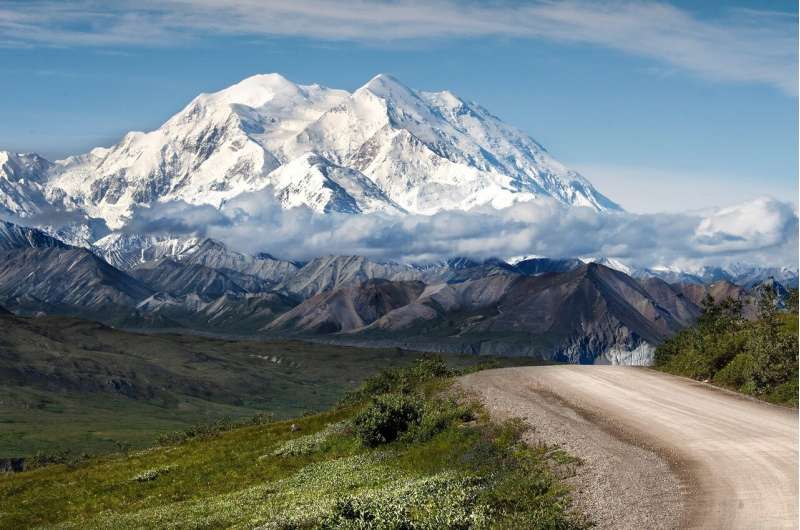
Credit: CC0 Public Domain
The melting of one of North America’s largest ice fields has accelerated and may soon reach an irreversible tipping point, according to new research colleagues and me, who published a study on the Juneau Icefield, which straddles the Alaska-Canada border near Alaska’s capital, Juneau.
In the summer of 2022, I skied across the flat, smooth, white plateau of the ice field, accompanied by other researchers, gliding in the footsteps of the person in front of me under a blazing sun. From this plateau, about forty immense, interconnected glaciers descend to the sea, with hundreds of smaller glaciers on the mountain peaks all around.
Our work, now published in Nature Communicationsshowed that Juneau is an example of climate “feedback” in action: as temperatures rise, there is less and less snow during the summer (technically: the “late summer snowline” rises). This in turn leads to more exposure of the ice to the sun and higher temperatures, which means more melting, less snow, etc.
Like many Alaskan glaciers, Juneau’s are very heavy, with lots of ice and snow at high elevations, above the late summer snowline. This used to support the glacier tongues lower down. But when the late summer snowline rises up to the upper plateau, a large portion of a very heavy glacier will suddenly be exposed to melt.
This is what is happening now, every summer, and the glaciers are melting much faster than before, causing the ice shelf to become thinner and thinner and the shelf to become lower and lower. Once a threshold is exceeded, these feedbacks can accelerate melting and cause a self-sustaining loss of snow and ice that would continue even if the planet stopped warming.
Ice is melting faster than ever
Using satellites, photos, and old rocks, we were able to measure the loss of ice from the Juneau Icefield from the end of the last “Little Ice Age” (about 250 years ago) to the present day. We found that the glaciers began to shrink after the end of this cold period, around 1770. This ice loss remained constant until about 1979, when it accelerated. It accelerated again in 2010, doubling the previous rate. The glaciers shrank five times faster between 2015 and 2019 than they did between 1979 and 1990.
Our data show that as snowfall decreases and the summer melt season lengthens, the ice field is getting darker. Fresh, white snow is highly reflective, and much of that strong solar energy we saw in the summer of 2022 is reflected back into space. But the late summer snowline is rising and now often occurs directly over the Juneau Icefield shelf, meaning older snow and glacier ice are exposed to the sun. These slightly darker surfaces absorb more energy, increasing snow and ice melt.
As the ice field shelf thins, the ice and snow reserves at higher elevations disappear and the shelf surface lowers. This will make it increasingly difficult for the ice field to stabilize or even recover. This is because warmer air at lower elevations causes additional melting, leading to an irreversible tipping point.
Long-term data like this are essential for understanding glacier behavior, as well as the processes and tipping points that exist within each glacier. These complex processes make it difficult to predict a glacier’s future behavior.
The hardest puzzle in the world
We used satellite data to reconstruct the size of the glacier and its behavior, but that really limits us to the last 50 years. To go back further, we need different methods. To go back 250 years, we mapped moraine ridges, which are large piles of debris deposited at the front of the glacier, and places where glaciers have eroded and polished the bedrock.
To verify and expand our mapping, we spent two weeks on the icefield itself and two weeks in the rainforest below. We camped among the moraine ridges, hung our food high up to protect it from bears, shouted to warn off moose and bears as we made our way through the rainforest, and battled mosquitoes that thirsted for our blood.
We used aerial photographs to reconstruct the ice field in the 1940s and 1970s, at a time when satellite images were not yet readily available. These photos are high quality, but they were taken before global positioning systems made it easy to pinpoint the exact location of the photos.
Some of them also suffered some minor damage in the intervening years: duct tape, a tear, a thumbprint. As a result, the individual images had to be stitched together to get a 3D image of the entire ice field. It was a bit like doing the world’s most difficult puzzle.
Work like this is crucial because the world’s glaciers are melting rapidly: together, they are currently losing more mass than the Greenland or Antarctic ice sheets, and the rate of thinning of these glaciers worldwide has doubled in the past two decades.
Our longer time series show just how marked this acceleration is. Understanding how and where “feedbacks” are causing glaciers to melt even faster is essential to making better predictions of future changes in this important region.
More information:
Bethan Davies et al., Acceleration of glacier volume loss on the Juneau Icefield driven by hypsometry and accelerating melt feedbacks, Nature Communications (2024). DOI: 10.1038/s41467-024-49269-y
Provided by The Conversation
This article is republished from The Conversation under a Creative Commons license. Read the original article.![]()
Quote:Alaska’s Heaviest Glaciers Approaching Irreversible Tipping Point (2024, July 6) retrieved July 7, 2024 from https://phys.org/news/2024-07-alaska-heavy-glaciers-approaching-irreversible.html
This document is subject to copyright. Apart from any fair dealing for the purpose of private study or research, no part may be reproduced without written permission. The content is provided for informational purposes only.